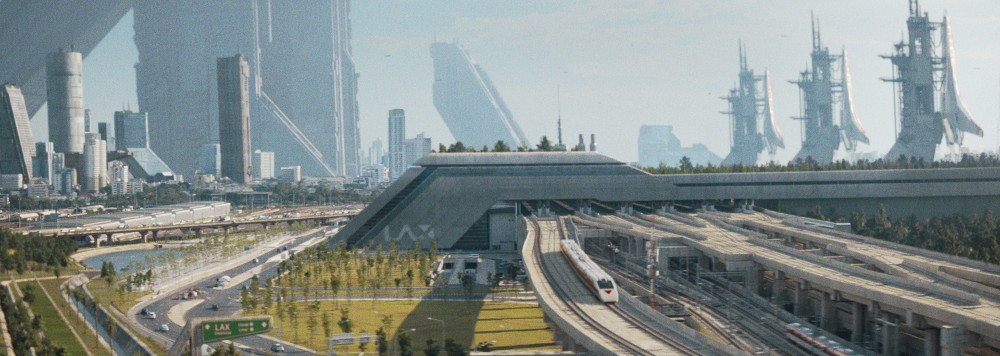
The look of Gareth Edwards’ new sci-fi epic The Creator is going to be something many who see the movie will be talking about, since it doesn’t look like any other sci-fi movie out there, even while treading in the familiar territory of a war between humans and A.I.
Edwards worked with Production Designer James Clyne, formerly of Industrial Light and Magic (ILM) in San Francisco, who helped attain Edwards’ vision of shooting the movie fully in Thailand with his actors to take advantage of that country’s beautiful vistas, then adding in all the robots, futuristic buildings and craft later.
Because of this, Clyne did much of his design work during the post process, allowing him, Edwards and the ILM team to build and modify this amazing futuristic world as needed to make The Creator look as jaw-droppingly gorgeous as it does. (Having Oscar-winner Greig Fraser as one of its DPs didn’t hurt either.)
Below the Line spoke with Clyne over Zoom to learn more about the unconventional techniques used to make The Creator such a distinctly original and visual film.
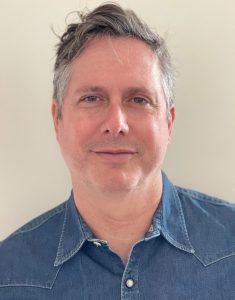
Below the Line: You, Gareth and the whole team did a great job on this movie. You’re a bit of a mystery, because I saw your name in the credits, and I looked you up, and this was the first movie you’ve production designed, so how did you and Gareth end up going on this adventure together?
James Clyne: I started in art departments and physical production art departments for a long time. I lived in LA, and I wanted to eventually work with ILM and get into understanding the VFX side of things, so I joined ILM in 2013. Several weeks after that, Disney purchased Lucasfilm and ILM, so everything changed on a dime, and they started up Star Wars.
I was fortunate enough to be part of the rebooting of Star Wars with ILM, Disney. I got to know a couple of the producers, Kiri Hart, I got to know well [through] a couple of the films. I didn’t work on Rogue One that much. I did a little bit of a concept work on that, but she introduced me to Gareth. We had lunch at Barney’s Beanery in Santa Monica, and we talked all things sci-fi for three hours. Everything you can name sci-fi from the ’70s, ’80s and ’90s. We talked about his movie a little bit, but it was more getting to know each other, and after that, I got the job.
BTL: Had he already been on his travels to Asia and documenting things that got turned into the sizzle reel?
Clyne: This was before he had done that. He was working with New Regency to get the film made. He had hired some concept artists to do some various concept art for the pitch, but once I was hired, he went out to Southeast Asia, shot a bunch of this beautiful footage, and we essentially made a 10-minute sizzle reel where John Knoll had a little splinter unit at ILM, and I designed these elements that we dropped into his photography.
From my understanding, that’s kind of what sold it to the studio, this process of shooting these exotic locations with actors and props and costume and then in post, adding elements – vehicles, buildings, robots after the fact. That process was a little bit backwards in terms of filmmaking. [In] pre-production, you design everything up front, and it follows this very linear movement towards post. We flipped things on their head a bit.
BTL: Were you still at ILM when you first met Gareth, and did you leave right away to do this movie?
Clyne: I was still at ILM but then I was eventually loaned out to the production once things started to kick off.
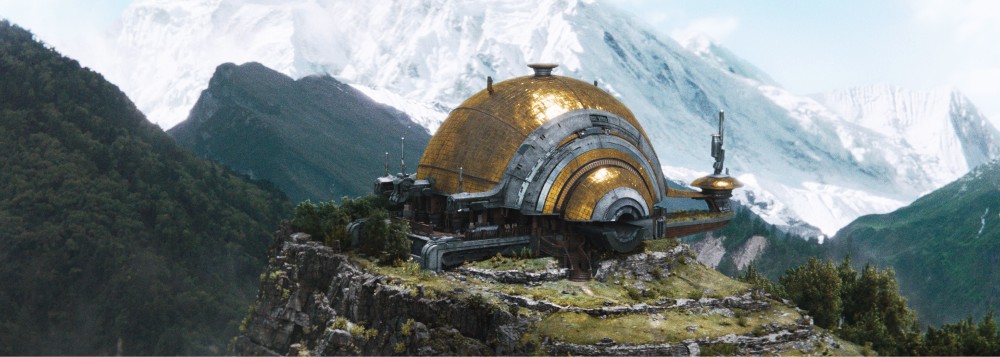
BTL: But you didn’t go on the original trip with him, though. He just kind of went on his own, was it with one of the DPs?
Clyne: It was just Gareth and the line producer, Jim Spencer, and a couple location managers. Gareth brought his own camera equipment, shot everything. I hope this little 10-minute proof of concept eventually makes it onto… do they still do blu-rays these days? I hope it winds up somewhere. I don’t know about the legalities ’cause he laced in music and sound effects on top of it, but it’s a beautiful little non-narrative piece that goes back to our original inspiration was this movie called Baraka.
BTL: I’ve never seen it, but I’ve heard of it.
Clyne: It’s amazing. It’s a beautiful non-narrative. Ron Fricke was the director. He just went around to all these amazing locations, shot beautiful photography. Our inspiration was, what if Baraka happened 50 years into the future? That was our initial inspiration for the visuals and the design language of the movie.
BTL: When he came back with the footage that you were going to turn into this sizzle reel, had you already designed stuff with ILM to put in? Were you already working on stuff that went on to become part of the movie?
Clyne: He brought back all this footage. We locked ourselves in a room at Lucasfilm for about three or four weeks, and we just sat there going over frames that he thought would be good frames to… “Let’s put a futuristic building back here. Let’s put a futuristic car. Let’s put robots in here.” Based on those “paint-overs,” we handed it over to John Knoll and his team to flesh out.
Funny enough, some of that original footage he took you’ll see in the movie. For example, the robot on the little moped with a bunch of bananas, and it’s all shot from a car. That’s part of that original footage. He actually cut in some of that original proof of concept into the film. There are a couple other pieces in there as well, but it’s a testament to working with really small teams to make high-end visual content.
BTL: I hope to see it again in IMAX next week, and I’ll look out to see if there’s a noticeable difference in quality.
Clyne: I don’t know if they had to go back in and do some tweaks to it, but Gareth’s not gonna want to do anything that’s not A-level quality across the board. He’s just gonna want it to be the best it possibly can. Look for the robot on the moped. There’s this massive mega structure. There’s a lot of them in the movie, but one that’s almost the shape of an Atari logo shot at night. That was another piece that we did for the initial test.
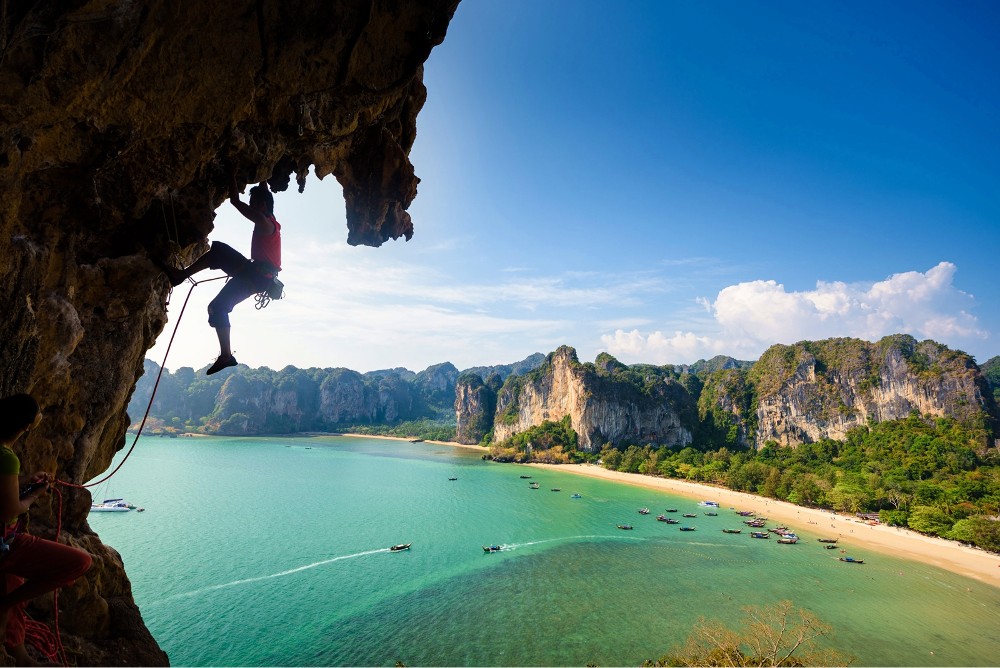
BTL: The movie is greenlit and financed by New Regency. Was there any sort of actual official location scout you went on, or did he already know the locations where he wanted to shoot?
Clyne: There was. What happened, unfortunately, was the pandemic, so that changed so many things. It’s hard enough to make a movie, let alone [having a] worldwide pandemic. Initially, we were gonna go to all these countries. We were gonna go to Cambodia, Vietnam, Thailand, Nepal. We eventually had a splinter unit shoot after principal photography and went back to some of those countries, but during the pandemic, we were locked into one country, because there was a two-week quarantine from country to country and just the shooting schedule would have just expanded enormously. So it was contained to Thailand.
I went out to Thailand, and we looked for locations. We were pretty specific on what worked for Gareth, what didn’t. Railay Beach, where you see the opening, there’s a little house where Maya and Joshua live. Gareth knew that beach. I think he had actually stayed in that house before the movie even got made. A lot of this was percolating in his head before the shoot. Because we had to stay in Thailand, we were limited, but we did travel quite extensively through Thailand.
BTL: I had wondered if something in the house would have been built and dressed up, or you worked with something that was already in place, and also the village with the piers, I wasn’t sure if that was something that was already there that got dressed up for the shoot.
Clyne: Because we had to keep our budgets tight, we leaned on locations as much as we could. We didn’t have a budget to build a massive bridge, but for the example of the house, there was a house we shot interior and exterior on Railay Beach. We set-dressed the interior, added books and little bits of tech, and all the set dressing that you see we added. But then, for the destroyed house, we built on another location on this river, and built a proper set, up to about 12-feet. We redesigned that set piece in post, but we had a physical set there that the actor could walk through.
In the example of the bridge, that was all existing. We were looking at multiple locations, kind of these floating village locations, most of which didn’t have a bridge, but the bridge location turned out to be a godsend in that it allowed Gareth to have this axis to shoot along, this foundation to base all his action from one side of the river to the other.
BTL: I’m not sure if ILM has made a VFX reel yet, but I’m sure it’s going to be amazing. I’m sure the monkey was visual effects.
Clyne: The monkey was real! The puppy was real. The monkey was real. Gareth wanted to use real animals. The monkey did not want to hit the detonator like Gareth wanted it to, but eventually, it did. The robot, specifically, were done in such a way [that] we didn’t have actors in green suits. We didn’t have many markers for the actors.
In fact, a lot of the decisions of who would be robots were all done in post. That was a conscious decision by Gareth, because he just wanted to shoot his movie and not worry about what was what. He wanted to move quickly and kind of guerilla style. His hope was that ILM would be flexible enough in post to make all that happen.
BTL: Were you actually on the shoot the whole time as well?
Clyne: We had two shoots. We had the main shoot, which was Thailand, and then we had a smaller London shoot, but it was more technical. At Pinewood, we did loads on the Stagecraft, and then we built probably eight set pieces. I went over to Thailand in prep, and then I left Thailand, and we had my supervising art director, Lech, oversee the shooting crew as they shot.
And then, I went over to London and prepped everything for London. London was at the end of the shoot, after they shot in Thailand, and then I would bounce back to San Francisco, and keep working on the designs that would all eventually have to be built in post. I was there, not as much in Thailand, but more in London and in San Francisco.
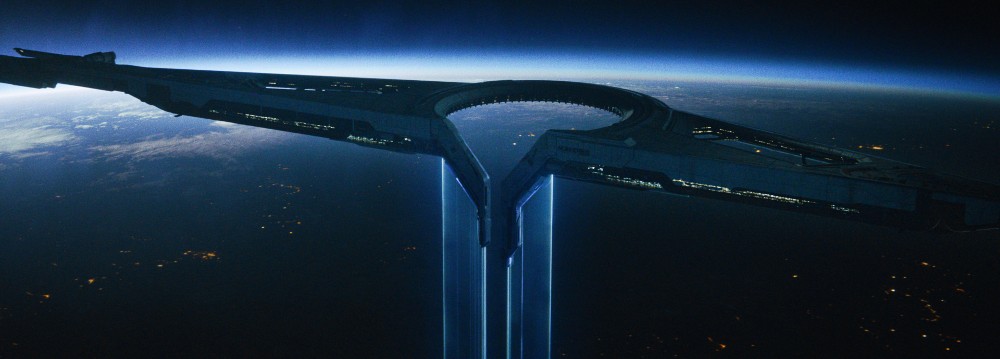
BTL: Let’s talk about some of the design aspects of The Creator. For instance, NOMAD is a great example. It’s an amazing visual, and something that, whenever it shows up, you know something bad is about to happen. Was there any inspiration for that, from which you and/or Gareth started with?
Clyne: That was a tough one, because we wanted something to look like it was real, like it could physically do what it did. We can make something believable, but we also wanted something that felt when the audience saw it, it looked intimidating, and it looked like it was going to do some harm. We did literally thousands of fast sketches of what it could be, and the shape of it and the silhouette. One day, we were just in the middle of it, trying to figure it out.
I’d seen an image from Pink Floyd’s The Wall, the movie, and one of the animated sequences, the black bird of prey, an almost Nazi symbolic shape. I just sent him that image. I was like, “What if we use this as a jumping off point for NOMAD, that it’s this striking bird of prey?” If you think about it, NOMAD is just floating high above the landscape, looking for its unsuspecting prey. He really liked that idea.
Whenever we design something, we tried to have a little bit of a story or metaphor behind it, and that seemed to really click with him. And then, after that, we would just drill down further and further what we needed, technically, for the movie, where the missiles would load, where the targeting beams would be fired from, the scale of it. All those technical things came after.
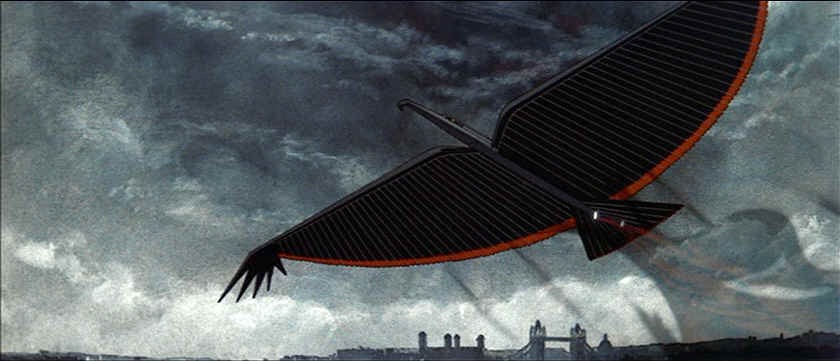
BTL: Do you start with hand-drawing or painting or something physical before going into the computers?
Clyne: Gareth really appreciates starting very rough. I like starting physically in a sketch form, just to try to get the ideas down. I think a lot of artists – and I tend to want to do it sometimes to — is just jump into 3D and start working it that way. I think there’s something to the germ of an idea happening in a sketchbook, so I keep these sketchbooks and do hundreds of drawings and bad notes in trying to get that idea. I think Gareth really responds to these very simple ideas starting on the page, rather than in the computer.
[NOTE: There is a minor SPOILER in the following response.]
BTL: The reason I asked about the hand-drawing is, because I speak with a lot of production designers, and it’s become standard for them to be working on computers from the beginning, which makes it easier for them to get things over to visual effects. I’m amazed that they can now design entire rooms with all the furniture on the computer.
Clyne: We started with sketches, but we went into virtual production for these two loads. We built very basic models of the sets, and Gareth loves VR. We actually went in there with [DP] Greig Fraser and myself and Gareth and did some VR tech-scouting in a couple of the sets. The last set you see where they’re going through that field on NOMAD, we did a VR tech scout, and then the escape pod, that big rotating pod door that Alfie escapes from, we did a whole tech scout on that as well. Both those sets started in very rough form, just on paper.
BTL: What do you do now? Do you have another project you’re starting to prep for?
Clyne: I’ve been doing some commercial work, trying to ride out the strike, and now that WGA has come through, I’m looking for my next project. I’m working on a very early development thing for Disney, but it’s super-early, but yeah, I’m just looking for the next project.
BTL: Great, this is an amazing film and quite different from the norm, since you’re doing so much of the design work after the shoot. I’ll be curious to see if others try to emulate what you and Gareth have done in other movies.
Clyne: It seemed to work for us, but as you know, every movie has a different way of proceeding. Maybe this can be done with other directors, who knows?
The Creator hits movie theaters across the nation on Friday, Sept. 29 with previews on Thursday night. Look for our interview with Industrial Light and Magic’s VFX Supe Jay Cooper and On-Set VFX Supe Andrew Roberts soon. You can also read a short interview with Gareth Edwards over at Above the Line.





